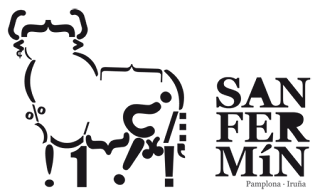The festival of San Fermín (or Sanfermines, in basque language Sanferminak) in the city of Pamplona (Navarre, Spain), is a deeply rooted celebration held annually from 12:00, 6 July, when the opening of the fiesta is marked by setting off the pyrotechnic chupinazo, to midnight 14 July, with the singing of the Pobre de Mí. While its most famous event is the encierro, or the running of the bulls, the week-long celebration involves many other traditional and folkloric events. It is known locally as Sanfermines and is held in honor of Saint Fermin, the co-patron of Navarre. Its events were central to the plot of The Sun Also Rises, by Ernest Hemingway, which brought it to the general attention of English-speaking people. It has become probably the most internationally renowned fiesta in Spain. Over 1,000,000 people come to watch this festival.
Saint Fermin
Fermin is said to have been the son of a Roman of senatorial rank in Pamplona in the 3rd century, who was converted to Christianity by Saint Honestus, a disciple of Saint Saturninus. According to tradition, he was baptised by Saturninus (in Navarre also known as Saint Cernin) at the spot now known as the "Small Well of Saint Cernin" Fermin was ordained a priest in Toulouse and returned to Pamplona as its first bishop. On a later preaching voyage, Fermin was beheaded in Amiens, France; and is now considered a martyr in the Catholic Church. It is believed he died on September 25, AD 303. There is no written record of veneration in Pamplona of the Saint until the 12th century. Saint Fermin, as well as Saint Francis Xavier, are now the two patrons of Navarre. At Pamplona, Saint Fermin; is now sometimes said to have met his end by being dragged through the streets of Pamplona by bulls, a fate more commonly attributed to his mentor, Saturnin.
The celebration of the festival has its origin in the combination of two different medieval events. Commercial secular fairs were held at the beginning of the summer. As cattle merchants came into town with their animals, eventually bullfighting came to be organized as a part of the tradition. Specifically, they were first documented in the 14th century. On the other hand religious ceremonies honoring the saint were held on October 10. However in 1591 they were transferred to the 7th of July to take place at the same time than the fair; when Pamplona's weather is better. This is considered to be the beginning of the Sanfermines. At that time they lasted two days but they were extended until the 10th and nowadays endure until the 14th. During medieval times acts included an opening speech, musicians, tournaments, theater, bullfights, dances or even fireworks. Bullrunning appears in 17th and 18th century chronicles together with the presence of foreigners and the first concerns on the excessive drinking and dissolute behavior during the event. The Giant's Parade was created by the end in the mid of the 19th century. The first official bullring was constructed in 1844.
Modern Times
The worldwide fame of the modern festival, and the great number of foreign visitors it receives every year, are closely related to the description by Ernest Hemingway's book The Sun Also Rises and his job as a journalist. He was greatly amused in his first visit in 1923 coming back many times until 1959. Hemingway was also deeply fond of bullrunnings and bullfights. Different city locations are famous in part due to the fact that the writer used to visit them, such as the La perla hotel, or the Iruña café.Single Day Events
Chupinazo
The opening of the fiesta is marked by setting off the pyrotechnic chupinazo (or txupinazo in Basque language). The rocket is launched at 12:00 noon on the 6th of July from a city hall balcony with thousands of people celebrating the act in the city hall square and other locations in Pamplona.The Riau-Riau
The Riau-Riau was a mass activity held on 6 July. The members of the city council would parade from the City Hall to a nearby chapel dedicated to Saint Fermín. Protesting youths would mass blocking the way, dancing to the Astrain Waltz played by the city band. The councilors would be stuck for hours sometimes being unable to exit the City Hall. The procession was finally removed from the festival calendar for political reasons as extremists used the "Riau-Riau" to promote unrest and clashes with authorities, police and other participants. Nevertheless in recent years in has been held unofficially without the participation of the members of the city council.San Fermin procession
The most important day of the festival is 7 July, when thousands of people accompany a replica of the statue of Saint Fermin along the streets in the old part of Pamplona. Saint Fermín is accompanied by dancers and street entertainers, such as the Gigantes and the Cabezudos and different political and religious authorities.Pobre de mí
After nine days of partying, the people of Pamplona meet in the Townhall Plaza at midnight on 14 July, singing the traditional mournful notes of the Pobre de Mí ('Poor Me'), in a candlelit ending.Daily events
Running of The Bulls
After the end of the run young cows with wrapped horns are released in the bullring and toss the participants, to the amusement of the crowd.















No comments:
Post a Comment